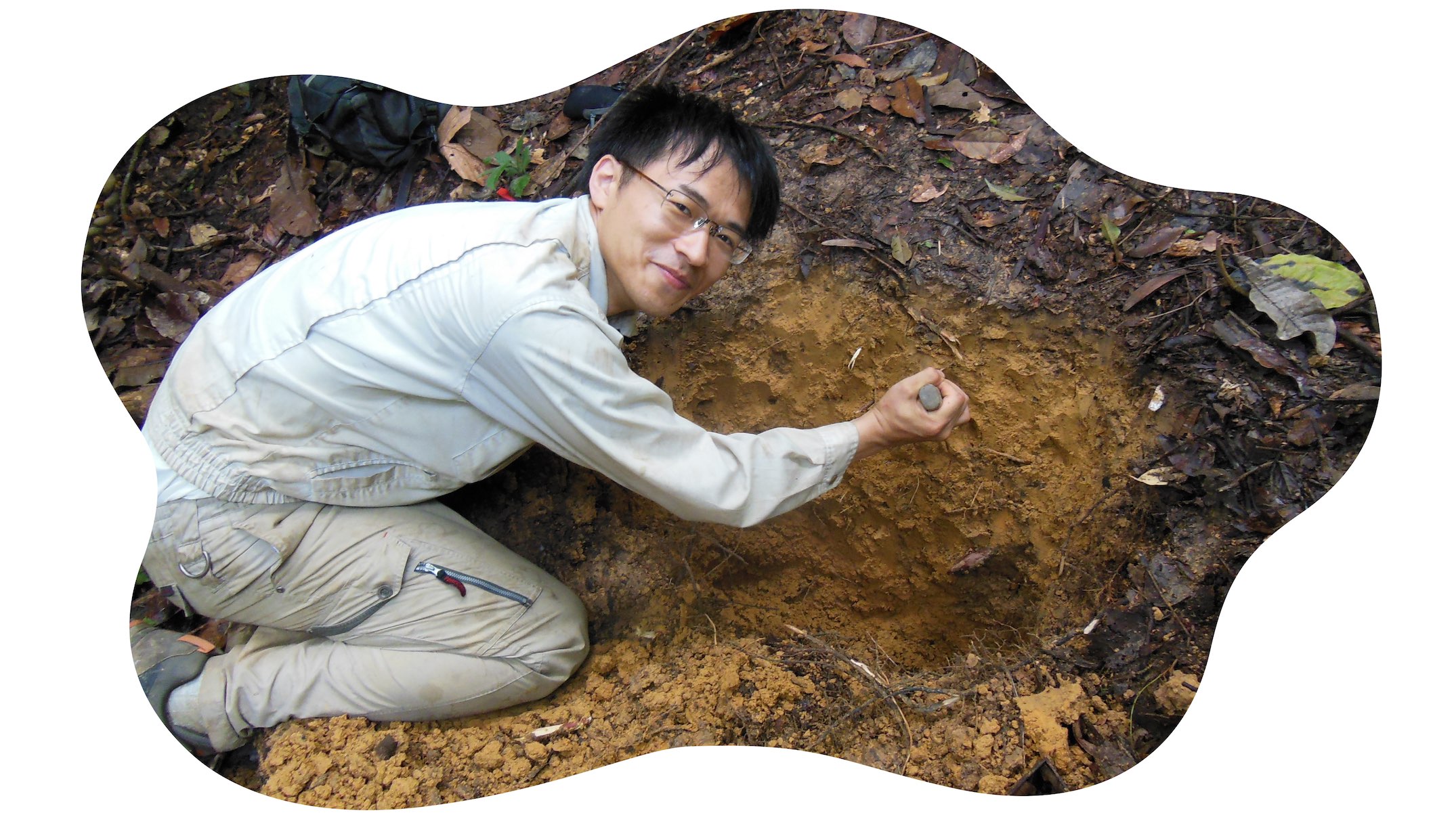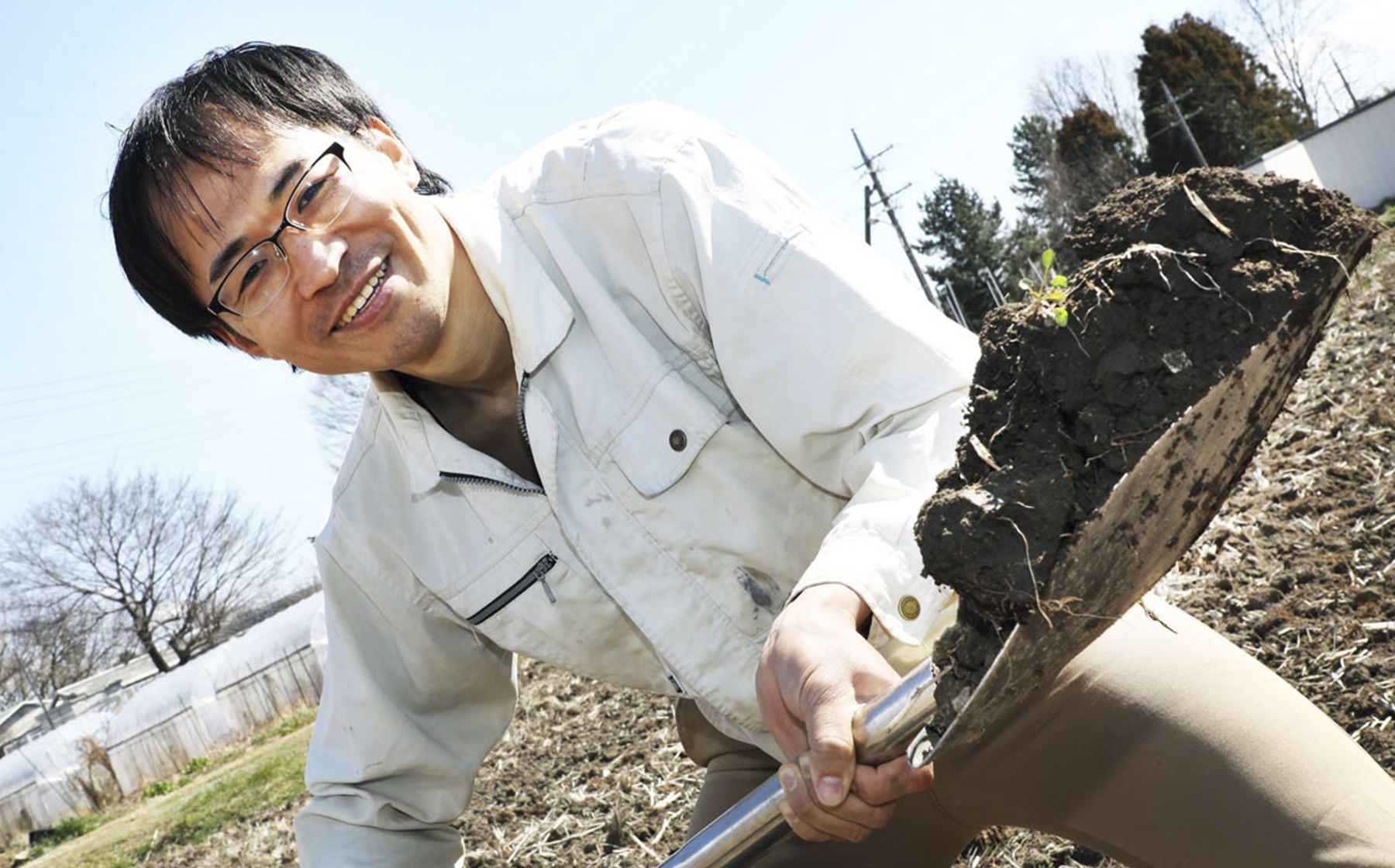

Dr. Fujii:
Today I would like to talk with soil scientist Dr. Kazumichi Fujii about the potential of enzymes. Dr. Fujii, what we call soil is a substance that is not found on any other planet, only on earth, isn’t it? How is soil created?
Dr. Fujii:
First of all, clay and sand in soil are created from rocks. Another component of soil is a substance called humus, which contains rotten plant materials such as leaves. Fallen leaves become leaf mold, which is eaten by insects, such as rhinoceros beetles, and then by microorganisms, and the final leftovers become humus.


ー
Around what percentage of fallen leaves becomes humus?
Dr. Fujii:
Virtually all fallen leaves are broken down by microorganisms, and so it’s said that only about 1% turns into black humus. Around 99% of carbon is returned to the atmosphere as carbon dioxide. Just one gram of soil is said to contain some 5 billion microorganisms and bacteria. Added to that are mold and fungi, such as mushrooms. But these are multicellular organisms, close to animals, and so it is difficult to know where one ends and the next begins, making it difficult to count them. Soil also contains organisms known as archaebacteria. So These groups known collectively as soil microorganisms are in the world within the soil and use enzymes in their activities.
Archaebacteria are microorganisms that live in environments that closely resemble the earth's primeval environment. They are involved in the breaking down of ammonia in the soil. Soil microorganisms utilize the actions of various types of enzymes to break down organic matter.



ー
Dr. Fujii, you began studying soil because you thought that it held the solution to the food crisis. This was also embodied in one of your books: “How can we ensure that the soil has the productivity to feed us all when the world’s population reaches 10 billion in the future?” Have we already reached the limit of productivity of the earth’s soil?
Dr. Fujii:
I have classified soil around the world into roughly 12 different types, but of these, only three are fertile soil. The fertility of the soil for food production—that is, the soil’s productivity—is determined by water and nutrients. The actions of microorganisms is essential in releasing the nutrients contained in fallen leaves and humus.


ー
In order to release the nutrients in water, we need enzymes that help fallen leaves dissolve in water. Let’s think of the human body as an example. Considering how humans eat, we tend to think that we absorb the nutrients by puttingfood into our mouths.However, in fact at that point, the food has merely gone into the long, tubular digestive organs; it has not yet been digested nor absorbed. Later, around 60% of the food is digested and absorbed with the power of bacterial enzymes in the intestines, and whatever remains is expelled from the body.
For example, in humans, vegetable dietary fiber cannot be broken down by digestive enzymes alone, and so the fiber is digested and absorbed with the power of bacterial enzymes in the intestines!





Dr. Fujii:
From the birth of life around 4 billion years ago until the present day, cells have used the process called membrane permeation in order to absorb nutrients dissolved in water. Plants, animals, and microorganisms all follow this rule at an individual cell level. Enzymes are the means by which nutrients are somehow dissolved in water.
ー
The enzymes of soil microorganisms have greater decomposition ability than those of bacteria in the human intestines, don’t they?
Dr. Fujii:
Yes, they do, however, such decomposition process takes a long time. Compared to the intestines, soil is rich in oxygen, however, there are few nutrients and many rivals to fight for limited nutrients. In my research we refer to decomposition enzymes, and in the sense that it is not just one enzyme that decomposes fallen leaves but rather various different microorganisms all contributing their respective abilities. The decomposition process is an “orchestra” rather than a solo performance.
Dr. Fujii:
The most important soil nutrient is nitrogen. For example, say that there are renge azaleas and clover growing along the side of a road where there is nothing but gravel. These plants can produce their own fertilizer. Leguminous plants are able to make ammonia from nitrogen gas. They can do this thanks to Rhizobium bacteria, which are microorganisms that live among the plants’ roots.
These bacteria have enzymes called nitrogenases. Because these enzymes can fix nitrogen, they are able to transform nitrogen in the air into ammonia—that is essentiallyfertilizer.
Nitrogenase is an enzyme that converts nitrogen molecules into ammonia—an incredibly difficult chemical reaction. However, it is highly vulnerable to oxygen and is, therefore, carefully stored somewhere within a microorganism where there is little oxygen.



Dr. Fujii:
The fallen leaves of plants with fixed nitrogen are virtually impossible to dissolve in water. Enzymes called proteases that are excreted by microorganisms break down proteins into amino acids, which are absorbed by the microorganisms. The microorganisms then release ammonia, which is converted into nitric acid through the action of nitrification bacteria. Each of these steps involve different enzymes. These processes form a lifecycle of the plants where they can grow.
Nowadays there is also research being carried out that analyzes how good the soil is by measuring the amounts of enzymes known as soil enzymes, isn’t there?



Dr. Fujii:
Yes, basic enzymes—such as proteases, which break down proteins, and β-glucosidases, which break down carbon sources—are indicators of the activity of microorganisms in soil. There are farmers who measure the activity of enzymes and microorganisms in soil and use this information as part of thier soil management. The cost of such analysis is much cheaper now than in the past.
Enzyme reactions are very complex. In some cases, compost has to be left to rest for two to three years for the enzyme reactions to function properly.



ー
In the past, farmers must have used instinct or experience to gauge the timing of enzyme reactions being performed by microorganisms.
Dr. Fujii:
In recent years, we have obtained scientific backing for many of the traditional fertilizers used by farmers . Virtually all reactions that break down organic matter involve enzymes, but it is not just one enzyme doing all the work but rather multiple enzymes acting in response to various different factors. As with human society, there is a complex society within soil.


Dr. Fujii:
Nitrogen fixation is an ability that microorganisms and plants have had for hundreds of millions of years, but humans do not have this ability. Therefore we have used leguminous plants, such as renge azaleas and clover, producing nitrogen for us, and we spread them over our crop fields as fertilizer, or fed them to cattle and then spread their excrement over our crop fields to improve soil productivity.
ー
You mean manure.
Dr. Fujii:
Eventually, however, around 1910, a method for chemically synthesizing ammonia from hydrogen and nitrogen, known as the Haber-Bosch process, was invented. Utilizing coal and oil, this process requires a tremendous amount of energy, but it enables humans to produce fertilizer without the use of enzymes. Incidentally, the world’s population at that time was around 1.9 billion.
ー
That’s less than a third of the world’s current population (7.7 billion as of 2019).
Dr. Fujii:
The amount of naturally occurring nitrogen produced by microorganisms and plants through enzymessuch as nitrogenases is around 100 million tons on earth today. The level of soil fertility and food production capacity has been limited to the amount of nitrogen generated by organic enzymes in nature, and so the world’s population did not grow above that limit.


Dr. Fujii:
Now, we add syntheic fertilizers to soil to grow crops. The amount of nitrogen has exceeded 100 million tons and it is still increasing. Consequently, the world’s population has also exceeded 7 billion and is expected to reach 10 billion around the middle of the 21st century.
Dr. Fujii:
Incidentally, with regard to how much fertilizer should be added to soil, the plants cannot over-absorb the fertilizer. Calculating the percentage of nitrogen added to soil that is actually passed on into our food, the average nitrogen utilization efficiency is around 40% worldwide. This means 60% is going to waste.
In developing countries, there is a persistent myth that more fertilizer you add, more crops you gain. However, in the reality the unused nitrogen is washed into rivers, causing algae proliferation in rivers and lakes, and these are also serious problems.


ー
So you’re saying that eutrophication (excessive nutrient enrichment) orthe excessive use of synthetic fertilizers, is causing environmental pollution and destroying the balance of the ecosystem. All these problems are happening because humans have the ability to produce more nitrogen than the nature does.
Dr. Fujii:
Excess nitrogen not only flows into waterways but also remains in tsoil, causing even more serious problems. When ammonia converts to nitric acid, the soil becomes acidic. It’s not as simple as “Well okay, the plants will simply absorb the nitrogen next year.”
If you want to return the soil to a neural state, you have to add lime. Using excessive nitrogen, and then adding sowing lime to neutralize the soil - —as a result, farmers are wasting their moneytwice over.
This is a different problem from the lime issue, but excessive sowing of phosphorus is also a problem. Some types of phosphorous are difficult for plants to absorb from soil, and an enzyme called phosphatase enables plants to utilize phosphorous effectively.



Dr. Fujii:
In tackling the food crisis, humans have resolved the nitrogen issue. However, there are various other issues that need to be addressedthe other nutrient-related issues such as phosphorous and calciumare limiting soil productivity. And then there is the eternal issue of water. If anything, nitrogen is preventing healthy human growth in the sense that excess nitrogen causes environmental pollutions.




What you were saying about how we end up using excessive nitrogen and how this is causing environmental pollution is incredibly concerning. I sincerely hope that there is something that we enzymes can do to help.What you were saying about how we end up using excessive nitrogen and how this is causing environmental pollution is incredibly concerning. I sincerely hope that there is something that we enzymes can do to help.



Dr. Fujii:
With carbon, the issues are easy to understand because of global warming, and so people have suggested ideas for solutions, such as imposing a carbon tax. However, the nitrogen issue is not so simple. In addition to fertilizers, humus also contains nitrogen. If this nitrogen can be broken down through the power of enzymes and utilized effectively, it will be possible to minimise the use of syntheic fertilizer, and so I am researching the technology in this area.
Even Dr. Fujii, who has been studying soil for many years, says that “The actions of microorganisms in soil are extremely complex.” It was only in the 19th century that humankind first discovered enzymes. Let’s travel back to prehistoric times to witness the birth of enzymes through the history of soil.
Continues in .Part 2Enzymes are active in every aspect of our world, and we are seeking new possibilities for them.
In this corner, we visit people who are currently active in various fields with "Enzo" and ask them about their stories.

